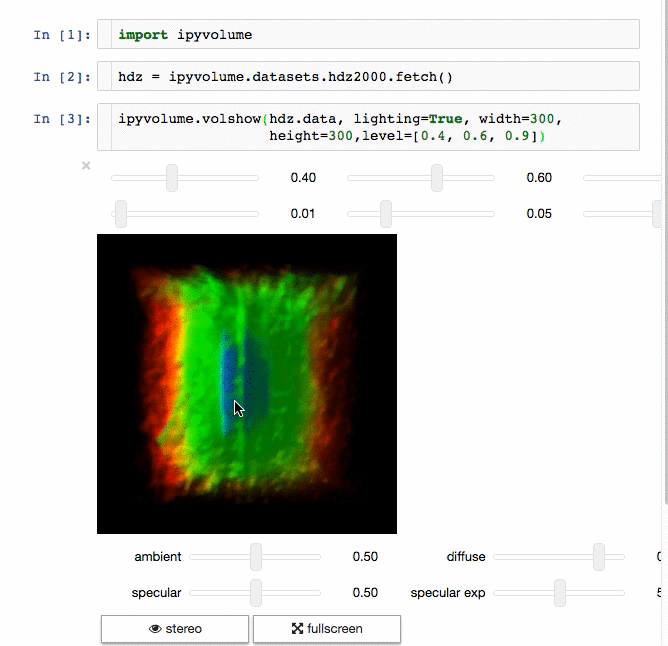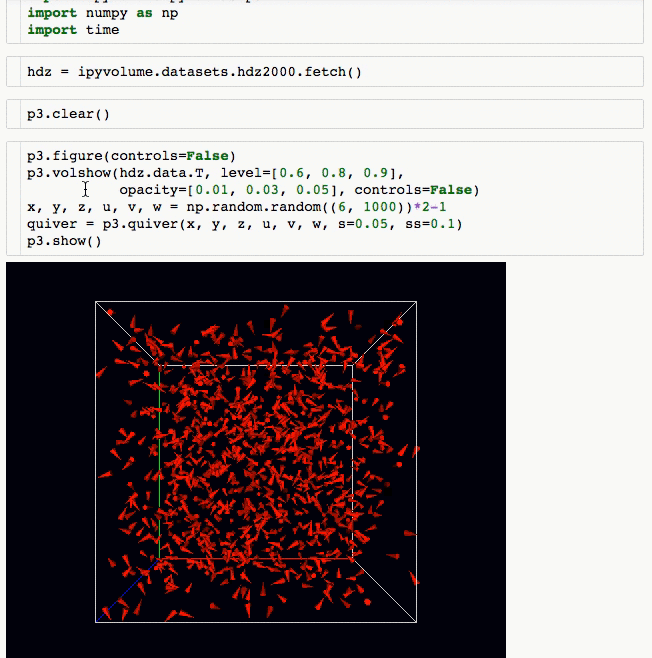https://github.com/widgetti/ipyvolume
3d plotting for Python in the Jupyter notebook based on IPython widgets using WebGL
https://github.com/widgetti/ipyvolume
dataviz ipython-widget jupyter jupyter-notebook plotting python quiver rendering-3d-volumes scientific-visualization threejs virtual-reality visualisation volume-rendering webgl
Last synced: 27 days ago
JSON representation
3d plotting for Python in the Jupyter notebook based on IPython widgets using WebGL
- Host: GitHub
- URL: https://github.com/widgetti/ipyvolume
- Owner: widgetti
- License: mit
- Created: 2016-12-21T15:30:13.000Z (almost 9 years ago)
- Default Branch: master
- Last Pushed: 2023-11-29T14:26:24.000Z (about 2 years ago)
- Last Synced: 2025-05-05T13:56:35.899Z (7 months ago)
- Topics: dataviz, ipython-widget, jupyter, jupyter-notebook, plotting, python, quiver, rendering-3d-volumes, scientific-visualization, threejs, virtual-reality, visualisation, volume-rendering, webgl
- Language: TypeScript
- Homepage:
- Size: 72.8 MB
- Stars: 1,961
- Watchers: 53
- Forks: 233
- Open Issues: 212
-
Metadata Files:
- Readme: README.md
- License: LICENSE
- Code of conduct: CODE_OF_CONDUCT.md
Awesome Lists containing this project
- best-of-jupyter - GitHub - 58% open · ⏱️ 07.07.2023): (Interactive Widgets & Visualization)
- StarryDivineSky - widgetti/ipyvolume
- awesome-jupyter-resources - GitHub - 56% open · ⏱️ 26.07.2022): (交互式小部件和可视化)
- awesome-scientific-image-analysis - ipyvolume - -> (🌻 Visualization / Software tools)
- awesome-starred - widgetti/ipyvolume - 3d plotting for Python in the Jupyter notebook based on IPython widgets using WebGL (jupyter-notebook)
- awesome-jupyter-widgets - ipyvolume - 3D plotting using WebGL (Interactive Widgets / Interactive Jupyter Widget Ecosystem)
README
# ipyvolume
[](https://gitter.im/maartenbreddels/ipyvolume?utm_source=badge&utm_medium=badge&utm_campaign=pr-badge&utm_content=badge)
[](https://ipyvolume.readthedocs.io/en/latest/?badge=latest)
[](https://pypi.python.org/pypi/ipyvolume)
[](https://anaconda.org/conda-forge/ipyvolume)
[](https://coveralls.io/github/maartenbreddels/ipyvolume)
[](https://travis-ci.org/maartenbreddels/ipyvolume)
Try out in mybinder: [](https://beta.mybinder.org/v2/gh/maartenbreddels/ipyvolume/master?filepath=notebooks/simple.ipynb)
3d plotting for Python in the Jupyter notebook based on IPython widgets using WebGL.
Ipyvolume currently can
* Do (multi) volume rendering.
* Create scatter plots (up to ~1 million glyphs).
* Create quiver plots (like scatter, but with an arrow pointing in a particular direction).
* Render isosurfaces.
* Do lasso mouse selections.
* Render in the Jupyter notebook, or create a standalone html page (or snippet to embed in your page).
* Render in stereo, for virtual reality with Google Cardboard.
* Animate in d3 style, for instance if the x coordinates or color of a scatter plots changes.
* Animations / sequences, all scatter/quiver plot properties can be a list of arrays, which can represent time snapshots.
* Stylable (although still basic)
* Integrates with
* [ipywidgets](https://github.com/ipython/ipywidgets) for adding gui controls (sliders, button etc), see an [example at the documentation homepage](http://ipyvolume.readthedocs.io/en/latest/index.html#built-on-ipywidgets)
* [bokeh](//bokeh.pydata.org) by [linking the selection](http://ipyvolume.readthedocs.io/en/latest/bokeh.html)
* [bqplot](https://github.com/bloomberg/bqplot) by [linking the selection](http://ipyvolume.readthedocs.io/en/latest/bqplot.html)
Ipyvolume will probably, but not yet:
* Render labels in latex.
* Show a custom popup on hovering over a glyph.
# Documentation
Documentation is generated at readthedocs: [](https://ipyvolume.readthedocs.io/en/latest/?badge=latest)
# Screencast demos
## Animation

(see more at [the documentation](https://ipyvolume.readthedocs.io/en/latest/animation.html))
## Volume rendering

## Glyphs (quiver plots)

# Installation
If you want to use Jupyter Lab, please use version 3.0.
## Using pip
*Advice: Make sure you use conda or virtualenv. If you are not a root user and want to use the `--user` argument for pip, you expose the installation to all python environments, which is a bad practice, make sure you know what you are doing.*
```
$ pip install ipyvolume
```
## Conda/Anaconda
```
$ conda install -c conda-forge ipyvolume
```
## Pre-notebook 5.3
If you are still using an old notebook version, ipyvolume and its dependend extension (widgetsnbextension) need to be enabled manually. If unsure, check which extensions are enabled:
```
$ jupyter nbextension list
```
If not enabled, enable them:
```
$ jupyter nbextension enable --py --sys-prefix ipyvolume
$ jupyter nbextension enable --py --sys-prefix widgetsnbextension
```
## Pip as user: (but really, do not do this)
**You have been warned, do this only if you know what you are doing, this might hunt you in the future, and now is a good time to consider learning virtualenv or conda.**
```
$ pip install ipyvolume --user
$ jupyter nbextension enable --py --user ipyvolume
$ jupyter nbextension enable --py --user widgetsnbextension
```
## Developer installation
```
$ git clone https://github.com/maartenbreddels/ipyvolume.git
$ cd ipyvolume
$ pip install -e . notebook jupyterlab
$ (cd js; npm run build)
$ jupyter nbextension install --py --overwrite --symlink --sys-prefix ipyvolume
$ jupyter nbextension enable --py --sys-prefix ipyvolume
# for jupyterlab (>=3.0), symlink share/jupyter/labextensions/bqplot-image-gl
$ jupyter labextension develop . --overwrite
```
## Developer workflow
### Jupyter notebook (classical)
*Note: There is never a need to restart the notebook server, nbextensions are picked up after a page reload.*
Start this command:
```
$ (cd js; npm run watch)
```
It will
* Watch for changes in the sourcecode and run the typescript compiler for transpilation of the `src` dir to the `lib` dir.
* Watch the lib dir, and webpack will build (among other things), `ROOT/ipyvolume/static/index.js`.
Refresh the page.